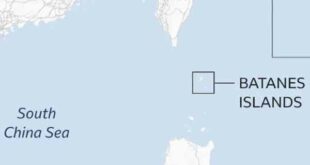Research on 70,000 animal species suggests nearly half are experiencing population declines.

A new study is sounding the alarm over global wildlife loss, painting what the authors call “a considerably more alarming picture” of worldwide species population declines than previously thought.
Of the over 70,000 animal species analyzed by the researchers in the recent study published in Biological Reviews, 48 per cent were found to have declining populations.
“What we are experiencing right now is the beginning of what we call a mass extinction,” said Daniel Pincheira-Donoso, evolutionary and climate change biologist at Queen’s University Belfast and lead author of the study.
Many conservation estimates only measure whether a species is currently at risk of extinction, but this study helps understand which direction species are heading in — only three per cent of the examined species were found to have increasing populations.
The report adds further evidence to a growingconcern over human-caused mass extinction, including a 2019 report from the United Nations found that over half a million species were at risk of extinction over the next several decades.
Experts warn that swift action is necessary to reverse the trend, and suggest a strategy to make that as effective as possible.
A new way to measure
Wildlife extinction risk is typically measured through “conservation categories” that indicate whether a particular species is currently threatened by extinction, says Pincheira-Donoso.
Instead of using the traditional categories, Pincheira-Donoso and his team opted to look at broader population trends to determine whether the population of a certain species was increasing, decreasing, stable or unknown.
“Instead of providing a snapshot of how species are doing right now, it provides a perspective through time,” he said.
While Pincheira-Donoso’s research found that nearly half of the species examined were in decline, the International Union for Conservation of Nature’s Red List only classifies 28 per cent of biodiversity as currently under threat.

Half of world’s species in decline, study suggests
A new study suggests half of the world’s species are in decline, amounting to what it warns is the widespread erosion of global biodiversity and another signal the planet is entering a mass extinction.
The Queen’s biologist says they also found that 33 per cent of species classified as non-threatened on the Red List, are in fact experiencing population decline.
“We can have species today that are tagged as being safe, not threatened. But if they are undergoing declines, we can expect that in the future they will be approaching levels of extinction risk,” he said.
Of the six categories of animals examined — mammals, birds, amphibians, reptiles, fish and insects — reptiles and fish were found to have the most stable populations while amphibians were found to have the most severe decrease.
Only three per cent of total species examined were found to have increasing populations.
Christina Davy, an assistant professor at Carleton University whose research lab studies species at risk in Canada, says the research fills a “really important gap,” by showing that species may be declining despite their conservation category.
“Species have to be collapsing pretty quickly to trigger a listing of threatened, endangered or vulnerable” she said.
“It’s possible for species to be declining slowly and not trigger those criteria and not meet those thresholds.”
Greater bang for our buck
Observing broader trends can perhaps lead to more effective biodiversity management, Davy says.
“We often end up chasing the most dire situations — the species that are on the brink of extinction,” she said, adding that in Canada, other species that are declining but not considered threatened may not be receiving the attention they need.
For instance, Davy says focusing on restoring the at-risk wetland plant scarlet ammannia might only help a small fraction of wetlands in Canada.

But restoring the habitat of a more common species like the snapping turtle — which is declining but not yet considered endangered — could help a far greater range of wetlands.
“If we were to preserve wetlands across Ontario, for example, to really protect the Canadian population of the snapping turtle, that would also benefit the more endangered wetland species like scarlet ammannia,” she said.
As Davy puts it, protecting common species may yield a greater “bang for our buck.”
Reversing the trend
While climate change is a growing threat for biodiversity, Pincheira-Donoso notes the main driver is a loss of habitat due to the conversion of natural landscapes into land for human activities — like city building, agriculture and roads.
“In the case of the modern biodiversity crisis, the major threat to biodiversity is habitat destruction,” Pincheira-Donoso said.

David Cooper, the acting executive secretary of the Convention on Biological Diversity, agrees that land use is a major concern when it comes to biodiversity.
“The total abundance of species — particularly animal species on the planet at the moment, and particularly larger animal species like mammals — has been massively reduced simply because humans, agricultural systems and livestock are taking so much more of the space,” he said.
Cooper notes the Kunming-Montreal Global Biodiversity Framework — an international agreement set at 2022’s COP-15 biodiversity conference in Montreal and aimed at tackling the biodiversity crisis — established actions to address these land-use issues.
“So we need more protected areas, but we need better protected areas and we need this in the context of the planning of the total landscape and the total seascape,” he said.
Cooper notes that the Kunming-Montreal Framework sets targets to restore ecosystems, mitigate climate change, and combat over-exploitation, pollution, and invasive species.
Lea Randall, interim senior manager of conservation translocations at the Calgary-based conservation organization the Wilder Institute, says her organization is increasingly taking an eco-systems focused approach to conservation.
“Trying to restore that habitat or make sure that the places you’re releasing them into are intact enough that it can support those populations is really key,” she said.
She notes that up to 70 per cent of wetlands have been lost in some parts of Canada and restoring the natural habitat for the benefit of one species can have knock-on benefits for other species that also make use of the area, she explains.
Humans rely on biodiversity which is why it’s of the utmost importance to prioritize conservation efforts, explains Cooper.
“A large proportion of our crops — and particularly the most nutritious ones — are dependent on animal pollination. The decline in abundance and the decline in diversity of those species is reducing production of many agricultural crops,” he said.
“We depend on nature, we depend on the diversity of species, but we’re also dependent on the abundance of many of these species.”
ABOUT THE AUTHOR

Writer
Adam is a journalist reporting on health, science and climate change.
*****
Credit belongs to : www.cbc.ca
 Atin Ito First Filipino Community Newspaper in Ontario
Atin Ito First Filipino Community Newspaper in Ontario






